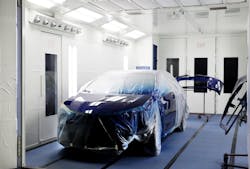5 ways to keep your paint booth clean and operating in peak condition
Proper cleaning and maintenance methods in your paint booth help promote higher-quality paint jobs, reduce rework and contribute to longer-lasting parts and components and are critical for the protection of your employees and facility. With spring cleaning now top of mind, here are the top five things you can do to protect your paint booth and keep your finishing equipment running efficiently:
1. Establish a preventive maintenance schedule
Global Finishing Solutions (GFS) or your local distributor offers preventive maintenance and service programs to ensure your paint booth stays in peak condition, in addition to saving your business time, hassle and costly repairs down the road. Customized to your needs, these programs may include just-in-time filter replenishment and replacement, paint booth cleaning, peelable booth coating application, complete diagnostic checks, and emergency service. Weekend and after-hours service are options to fit within your shop’s schedule and reduce downtime.
A maintenance schedule provides guidelines for how often to inspect, clean and replace key components of your paint booth, such as intake and exhaust filters. While some components should be inspected and cleaned daily, others may require only an annual inspection, depending on your paint booth usage.
2. Regularly change paint booth fillers
Replacing intake and exhaust filters on a routine basis is one of the simplest things you can do for the cleanliness and overall productivity of your paint booth. Proper airflow can be hindered by clogged or overloaded filters, causing dust or overspray to recirculate and affecting the finish of your paint job. The likelihood of equipment failure is decreased by regularly changing your booth’s filters, in addition to helping ensure your booth is operating efficiently and keeping the production costs of your shop low.
To measure a pressure differential, a manometer indicates when paint booth filters are loaded and need replacement. By monitoring the filters with your manometer, painters and service personnel know when it is time to change the filters. If your booth lacks a differential pressure gauge, a strict maintenance schedule should be established based on the time spent spraying in the booth.
Perhaps the most common maintenance mistake made by shops is not following the filter changeout schedule specified by their paint booth manufacturer. While your booth’s exhaust filters should be changed every 100 operating hours or every three to four work weeks, each paint operation is different, which may require changing exhaust media more frequently.
3. Protect your paint booth walls with strippable coatings
Strippable paint booth coatings offer outstanding coverage to protect your equipment, shop and employees, making it is easy to keep the walls of your booth clean. Booth Shield from GFS traps the overspray that collects on booth walls, so you can save valuable time, avoid unnecessary hassle and achieve better-quality paint finishes.
While temporary, strippable booth coatings keep your paint booth cleaner, they also help your booth last longer. Since white walls are more reflective to create a brighter spraying environment, strippable coatings boost visibility and aid in precise paint application. Lasting as many as 700 booth cycles, booth shield reduces rework and decreases the frequency of cleaning required for your booth.
4. Use a protective floor covering in your paint booth
Trapping overspray, dirt, dust and particles for better-quality paint finishes and a safe, bright working environment, the PIG Grippy Mat from GFS is a unique, adhesive floor covering for paint booths. It is simple to install and peels up easily for quick change-outs. Plus, sweeping or vacuuming the PIG Grippy Mat is enough to remove overspray, dust and debris, saving the hassle of scraping or using chemicals on the floor of your booth.
The PIG Grippy Mat can last up to three months, depending on the amount of overspray and cleaning. The mat is durable enough to withstand foot and vehicle traffic. The padding on the PIG Grippy Mat makes standing and kneeling more comfortable while reducing noise. The bright gray color of the PIG Grippy Mat also helps evenly distribute light and eliminates shadows and reflections on paint jobs.
5. Active summer/winter mode on your AMU
To ensure consistency for both spraying and curing, in addition to increasing efficiency and reducing rework, the temperature in your paint booth should be regulated, regardless of the temperatures outside. A baseline temperature for the booth is more easily established with summer/winter mode on GFS air make-up units (AMUs). So even as the seasons change, some of the problems associated with frequent temperature fluctuations are eliminated, keeping your finishing operation running smoothly.
Summer mode on GFS control panels should be turned on in the spring, usually in April, when cool mornings can give way to warm afternoons. The switch to winter mode is best in the fall, typically in October, when the weather is perhaps the most unpredictable.
With summer mode activated, the burner on the paint booth heater remains off when the booth is in spray mode. For winter mode, the burner turns on in spray mode, providing heat and humidity control to the booth. A 10-degree bump above ambient temperature is attainable with the burner on, especially helpful for working on temperature-sensitive products. Already having the burner on is also a time saver when it comes time to cure.
About the Author

Troy Volbrecht
Troy Volbrecht is the senior territory manager, refinish, at Global Finishing Solutions (GFS).
